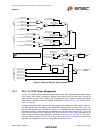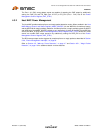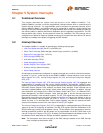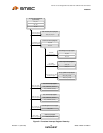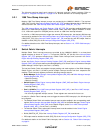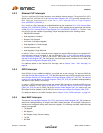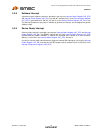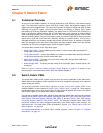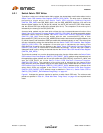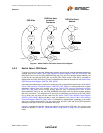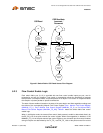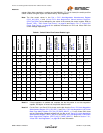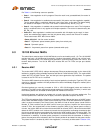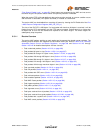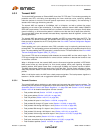
Two Port 10/100 Managed Ethernet Switch with 16-Bit Non-PCI CPU Interface
Datasheet
SMSC LAN9311/LAN9311i 55 Revision 1.4 (08-19-08)
DATASHEET
Chapter 6 Switch Fabric
6.1 Functional Overview
At the core of the LAN9311/LAN9311i is the high performance, high efficiency 3 port Ethernet switch
fabric. The switch fabric contains a 3 port VLAN layer 2 switch engine that supports untagged, VLAN
tagged, and priority tagged frames. The switch fabric provides an extensive feature set which includes
spanning tree protocol support, multicast packet filtering and Quality of Service (QoS) packet
prioritization by VLAN tag, destination address, port default value or DIFFSERV/TOS, allowing for a
range of prioritization implementations. 32K of buffer RAM allows for the storage of multiple packets
while forwarding operations are completed, and a 1K entry forwarding table provides room for MAC
address forwarding tables. Each port is allocated a cluster of 4 dynamic QoS queues which allow each
queue size to grow and shrink with traffic, effectively utilizing all available memory. This memory is
managed dynamically via the buffer manager block within the switch fabric. All aspects of the switch
fabric are managed via the switch fabric configuration and status registers (CSR), which are indirectly
accessible via the memory mapped system control and status registers.
The switch fabric consists of four major block types:
Switch Fabric CSRs - These registers provide access to various switch fabric parameters for
configuration and monitoring.
10/100 Ethernet MACs - A total of three MACs are included in the switch fabric which provide basic
10/100 Ethernet functionality for each switch fabric port.
Switch Engine (SWE) - This block is the core of the switch fabric and provides VLAN layer 2
switching for all three switch ports.
Buffer Manager (BM) - This block provides control of the free buffer space, transmit queues, and
scheduling.
Refer to Figure 2.1 Internal LAN9311/LAN9311i Block Diagram on page 21 for details on the
interconnection of the switch fabric blocks within the LAN9311/LAN9311i.
6.2 Switch Fabric CSRs
The switch fabric CSRs provide register level access to the various parameters of the switch fabric.
Switch fabric related registers can be classified into two main categories based upon their method of
access: direct and indirect.
The directly accessible switch fabric registers are part of the main system CSRs of the
LAN9311/LAN9311i and are detailed in Section 14.2.6, "Switch Fabric," on page 230. These registers
provide switch fabric manual flow control (Ports 0-2), data/command registers (for access to the indirect
switch fabric registers), and switch MAC address configuration.
The indirectly accessible switch fabric registers reside within the switch fabric and must be accessed
indirectly via the Switch Fabric CSR Interface Data Register (SWITCH_CSR_DATA) and Switch Fabric
CSR Interface Command Register (SWITCH_CSR_CMD), or the set of Switch Fabric CSR Interface
Direct Data Register (SWITCH_CSR_DIRECT_DATA). The indirectly accessible switch fabric CSRs
provide full access to the many configurable parameters of the switch engine, buffer manager, and
each switch port. The switch fabric CSRs are detailed in Section 14.5, "Switch Fabric Control and
Status Registers," on page 309.
For detailed descriptions of all switch fabric related registers, refer to Chapter 14, "Register
Descriptions," on page 167.



